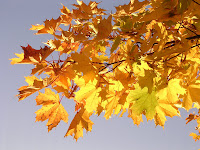 The fall colors are just about gone for the year, and leaves are falling fast. I love fall. This time of year the larches in Shevlin Park have gone from green to yellow and are in the midst of dropping their needles. Big sections of the park are covered with a carpet of yellow. As always, I enjoy the scene as a regular person, thinking stuff like "gee, that's pretty!" and "wow, cool, needles falling off a conifer!" but I also can get geeky and enjoy the scene from a chemist's viewpoint. "Gee, anthocyanins!" and "what's the name of that protein that makes the leaves actually drop?!" and "why do some trees have so many reds when others in the same habitat are so yellow?"
The fall colors are just about gone for the year, and leaves are falling fast. I love fall. This time of year the larches in Shevlin Park have gone from green to yellow and are in the midst of dropping their needles. Big sections of the park are covered with a carpet of yellow. As always, I enjoy the scene as a regular person, thinking stuff like "gee, that's pretty!" and "wow, cool, needles falling off a conifer!" but I also can get geeky and enjoy the scene from a chemist's viewpoint. "Gee, anthocyanins!" and "what's the name of that protein that makes the leaves actually drop?!" and "why do some trees have so many reds when others in the same habitat are so yellow?"It's delightful to think that the bright colors so noticable at the peak of fall are actually hiding behind the greens of the chlorophylls all summer long. While we don't eat tree leaves (do we?) we do hunt down highly-colored fruits and vegetables that contain pigments like lycopene and beta carotene because they are health-promoting. What do all these colored substances have in common? They're typically highly-conjugated alkenes. Lots of double bonds, large molecules, lots of resonance structures, loosely-held electrons, ready to be promoted to higher energy levels with just a minimum-energy photon: one that falls into the range of the visible. This is chemically why they are colored. For those of you who understand: small HOMO LUMO gaps.
These same double bonds make those fruits and vegetables we love susceptible to darkening from oxidation if they're left out in the air for too long. I have heard it suggested that tree leaves may contain some of these compounds to protect them from the damage of high-intensity light in the visible and uv range. That they absorb the energy of the visible light and in so doing keep other more critical molecules from being damaged. How curious.
Maestro Chem Educator Bassam Shakhashiri has a great page on fall colors here:
http://scifun.chem.wisc.edu/chemweek/fallcolr/fallcolr.html
Here's a link to a journal article about anthocyanins, which are red and purple, as protective compounds:
http://www.pubmedcentral.nih.gov/articlerender.fcgi?artid=125091
And about that supposed protein I thought was involved in leaf dropping: the compound I thought responsible is abscisin.....actually abscisic acid. It's not a protein (as is suggested vaguely by the original name). And turns out Wikipedia says it's not even thought to be involved in leaf drop anymore, even though that's how it got its name.
No comments:
Post a Comment